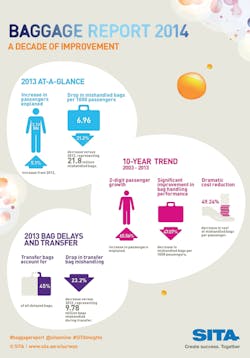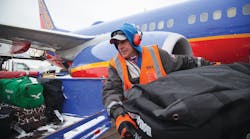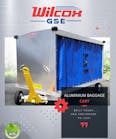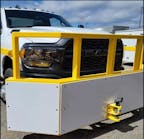Airline baggage delivery hit an all-time high in 2013, with the mishandling rate dropping more than 21 percent from 2012, according to air transport IT specialist, SITA.
The group’s 10th annual SITA Baggage Report reports that the rate of mishandled bags in 2013 was less than 7 bags per 1,000 passengers. This is just half the rate reported 10 years ago, despite a more than 65 percent increase in passenger numbers over the same period of time.
From 2012 to 2013, the rate of mishandled bags dropped 21 percent, and the total annual cost of mishandled bags to the industry fell nearly 20 percent. That puts the annual cost of mishandled bags is 50 percent less than in 2007, when the number of mishandled bags peaked at more than 18 bags per 1,000 passengers. The industry has achieved this improvement even as passenger numbers rose more than 5 percent in 2013 to top 3 billion passengers globally.
“The industry has joined together to tackle the problem of mishandled bags, and we have seen great results,” said Francesco Violante, CEO, SITA, in prepared remarks. “There is still more work to do, but 2013 was the best year ever, showing the benefits of this collaboration.”
More immediately, 2013 was another year of improvement for the largest cause of baggage snafus. SITA reports that while transfer bags continue to suffer the most baggage delays. In 2013, for example, they accounted for 45 percent of all delayed bags, but this was an improvement of the 48 percent seen in 2012 and continued the downward trend seen over the past six years when transfer bags represented well over half of all mishandled baggage.
“A large part of the improvement in handling transfer baggage is down to greater messaging reliability and better segregation of bags with short connection times, as well as the introduction of early bag stores and smart mobile device for key operational staff,” Violante writes in the preface of the report.
PROGRESS MADE
Annual mishandled bags cost the industry a total of $2.09 billion in 2013, according to the report. But that’s an almost 20 percent reduction from 2012, which cut the cost of mishandled bags per passenger to 67 cents.
To put this in some perspective, in 2013 the aviation industry’s operation cost was $219 per passenger and the industry average profit margin per customer was $7.50. While the cost of mishandled bags per passenger represents just 0.31 percent of that operating overhead, reducing expenditures on mishandled bags would have a positive impact on the profit margin.
To further understand the progress made, it helps to look at the 10-year trends the report spells out.
The past ten years have seen passenger numbers grow by 67 percent, from 1.89 billion in 2003. In the same period the aviation industry has weathered a tough economic cycle as profits were heavily dented by global recession after the boom of 2007.
Despite this considerable challenge, the total number of bags mishandled reduced by 12.5 percent across the 10 years and the total bag mishandling cost to the industry was cut by 6 percent. The economic pressures are clearly reflected in the long-term bag handling trends. In the first five years there was a rapid rise in the number of mishandled bags, with a year-on-year increase of 4 percent in 2004 growing to a year-on-year rise of 32 percent in 2007. The total bag mishandling cost to the industry followed a similar pattern, rising 4 percent in 2004 to a year-on-year rise of 32 percent in 2007. In that year the total number of mishandled bags peaked at 46.9 million and the total mishandling cost to the industry topped out at $4.22 billion.
The number of mishandled bags per 1,000 passengers also reached a 10-year high of 18.88. However, as recession tightened its grip throughout 2008 and 2009, the aviation industry tackled costs, and worked to improve the passenger experience, by addressing baggage mishandling issues. A number of technical innovations, plus an industry initiative supported these improvements. In 2008, for example, the International Air Transport Association launched its Baggage Improvement Program, an industry-wide action plan, which ran until 2012, to help airports and airlines identify areas where they could reduce bag mishandling. The aim was to achieve a 50 percent reduction in the mishandled bag rate.
TRANSFER BAGS
The report highlights the adoption of “pull technology”, which can be used to build flights more intelligently.
“Early bags are stored and then called forward by the system, along with on-time bags to a make-up area, where all the bags for the flight arrive within a specific time period,” the report says. “Instead of bags arriving over a period of one or more hours, all bags arrive at the baggage make-up area within a much shorter time, here baggage staff or robots quickly build the containers for a flight.”
However, at the other end of the spectrum lies the challenge of the transfer bags.
“The transformation in transfer bag performance over the past eight years has been helped by greater messaging reliability, enabling bags with short connection times to be identified before they arrive at the airport,” the report states. “This allows ‘runners’ to be dispatched to the aircraft to find and separate out any ‘short connect’ bags.”
The way bags are segregated in the aircraft has also been improved, the report adds, with smart bag systems building the load to ensure “hot bags” with a 45-minute turn around can be off-loaded first, while those bags with more than a 90-minute turnaround times are unloaded afterwards.
On the technical side, there has been increased tracking of bags throughout the handling systems and at various stages of processing them onto the aircraft via scanning of the barcode on the bag-tag, either on handheld scanners or via automatic reader arrays in the baggage handling system. This information can be shared, so if the airport has the appropriate technology, it has a greater understanding of what is happening to the bags at any given time and can identify and react to problems.
More recently, some airports and airlines have also started scanning arriving bags terminating or transferring at the airport, which allows them to both monitor ground handler performance and confirm that bags have arrived.
Baggage handling technology has become more and more sophisticated over the last 10 years. Short connection times mean that bags must be handled quickly and efficiently. The solutions required are influenced by the physical attributes of the airports. Where bags only need to travel short distances, belt-based handling systems can provide cost-effective solutions; however as bags need to travel further (and faster), then high-speed solutions such as destination-coded vehicle (DCV) systems are able to quickly move bags around the airport, ensuring that minimum connect times are met.
While transfer bags comprise the majority of delayed bags, the report also includes details for other baggage mishaps. For example,"failures to load" accounted for 16 percent of delays. "Ticketing errors/bag switches/security and other" accounted for 15 percent of these delays.







